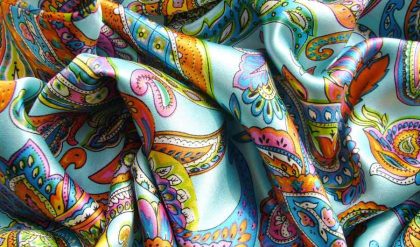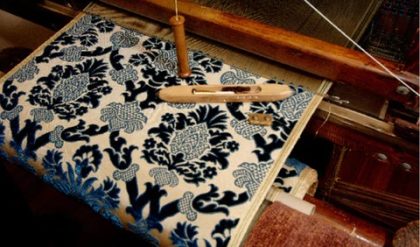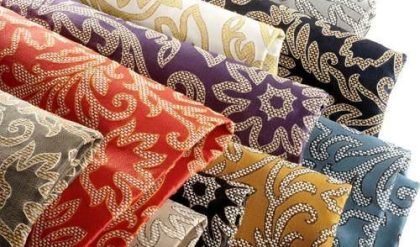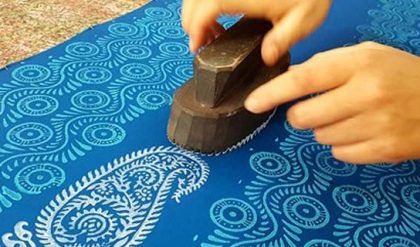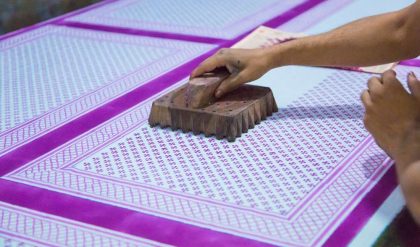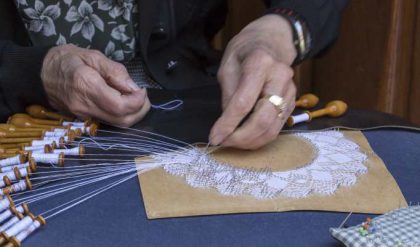In the design of digital jacquard textiles, the nature and principle of colour mixture appropriate for the fabric cannot be neglected. Not only do these principles govern the colour expression on the face of the fabric but they also advance the innovation of structural design methods for jacquard fabrics. The expression of woven patterns and the colours of jacquard fabric interlacing through warp and weft threads must be realised based on the woven construction and deployment of colour threads, both warp-wise and weft-wise. Generally, in traditional plane design mode, the number of mixed colours on the face of a jacquard fabric was less than 100, due to mutual covering effects caused in the fabric’s construction. Thus, the colour design of jacquard fabric was an experience-based undertaking, and research in colour mixture theory was irrelevant for jacquard fabric design.
However, with the proposed layered-combination design mode, especially for the full-colour compound structure design method, digital jacquard is able to express true-colour effects with millions of mixed colours. The colour performance of digital jacquard textiles can now exceed the scope that the eye can distinguish, and has surpassed the design competence of skilled manual labour. Mastering the nature of colour mixing has become one of the most important factors in the design creation of digital jacquard textiles.
Research into the colour mixture of jacquard fabrics has taken two major directions: the fi rst is colour simulation through a computer-based system on a fi xed fabric structure; the second is simulation design of jacquard fabric based on limited primary colour threads. These two research directions aim to increase the design effi ciency of jacquard fabric, yet are very much based on the traditional plane design mode of jacquard fabric. The fi rst direction addresses the design problem of colour matching of jacquard fabric: based on a fi xed fabric structure, computers can be used to simulate changing colour effects through the variation of warp and weft threads, without the need for actual production. Although the design effi ciency of colour simulations of jacquard fabric has increased, colour mixture theory, due to the lack of innovation in fabric structure, is the same as that of traditional design methods for jacquard fabric. The second research direction focuses on the establishment of an ideal colour model with limited primary colours, targeting the design of jacquard fabric to imitate given images via the disposition of limited primary threads.
At present, there are two types of proposed colour model, viz. primary colour model and designated colour model. The primary colour model involves part, or all, of the fi xed primary colours of red, magenta, yellow, cyan, blue and green with the support of black and white. The designated colour model consists of changeable colours selected on the basis of the colour effect of an objective image, normally with 4–8 designated colours in the model. Due to the lack of design innovation in fabric structure, even when the colour model is in theory optimal, the available structure design fails to support it. To avoid the insuffi ciencies inherent in design application, the use of a colour table/chart has been proposed, i.e. designing and weaving fabric colour samples to form a fi xed colour table/ chart prior to the design of the fabric. However, such a method has been useful only for designing jacquard fabrics with the same fabric technical specifi cation
In terms of colour design theory, the simulative effect of jacquard fabric can be better realised by the use of more threads of primary colours. However, when more colours are used as warp and weft threads, the compound fabric structure becomes so complex that it is diffi cult to attempt. Therefore, a balance point between the number of primary colours and the design of the fabric structure should be considered for colour mixing on jacquard fabric. Such a balance point can be realised only through an innovative design of the fabric structure. Thanks to the proposed layeredcombination design mode, restrictions in the structural design of jacquard fabric have been freed. Now, jacquard fabric is able to express millions of mixed colour effects accurately.
The colour mixing of jacquard fabric is different from that of colour mixing in artworks created in other media, such as in painting, printing, or on the screen display of a computer. In terms of colour science, there are three typical colour mixture theories: the additive colour mixture of light (corresponding to a computer’s RGB digital colour mode); the subtractive colour mixture of pigment (corresponding to a computer’s CMYK digital colour mode); and optical colour mixture (with no corresponding digital colour mode) (Green, 1999). Essentially, additive and subtractive colour mixtures are physical phenomena. However, optical colour mixture is a kind of physiological phenomenon, i.e. it is a colour illusion caused by the visual defi ciency of the human eye. In terms of the colour characteristics of jacquard fabric, its colour mixture is an optical colour mixture. Optical colour mixtures can be divided into two types, in terms of their application: juxtaposition mixture and rotatory mixture: the former is a kind of static spatial colour mixture, while the latter is dynamic. Since the colour mixture of jacquard fabric is a static phenomenon, it has to do with the theory of static colour mixture. Therefore, the colour mixing of jacquard fabric can be seen as a kind of juxtaposition mixture of optical colour mixture. The physical colour mixing principle is inadequate to explain the changes of colour on jacquard fabric. In order to investigate the changing rule of mixed colour and colour mode during the design process of jacquard fabric, the infl uences pertinent to the colouring effect of jacquard fabric (such as the design of the fabric structure, the disposition of the colour threads, and even the fabric technical specifi cation itself) should be taken into account.
